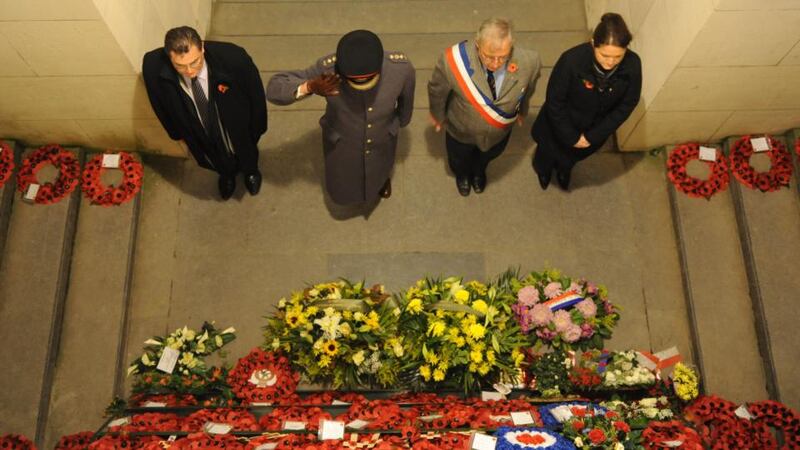Deep in the quiet Belgian countryside lies Tyne Cot cemetery, the largest commonwealth graveyard in the world. The nine-acre site houses rows of white gravestones, their haunting symmetry a chilling contrast to the relentless chaos that unfolded here a century ago.
Everywhere in this corner of Flanders are reminders of the first World War. Passchendaele, Ypres, Menen – the names of these Flemish towns have become synonymous with a war that shook civilisation to its core.
Belgium has long been a site of pilgrimage. This year it expects an upsurge of visitors as the world prepares to mark the centenary of the Great War.

On this early summer morning, the bustling market town of Ypres is packed with tour groups and visitors stopping into the town’s museum or awaiting guides to bring them to the nearby battle sites.
Each evening, the last post is played at the Menin Gate, a tribute to the fallen soldiers – many of them Irish – who never returned. But the question of how to commemorate a war that left a continent in ruin is a complex one. Already, in Britain, the education secretary Michael Gove stoked controversy, accusing "left-wing academics" of perpetuating revisionist versions of the war.
Jay Winter, professor of history at Yale University and the author of Sites of Memory, Sites of Mourning, one of the definitive works on the history of first World War commemoration, says the way in which the centenary of the Great War is marked is hugely important.
“Firstly, the word ‘celebration’ has to go,” he says.
“Commemoration and celebration are two very different concepts. Of course there was a victory, [there was] an Allied victory and the central powers were defeated, but the concept of commemoration has an act of recognition of slaughter right at its core.
“The overwhelming message – and most teachers of history I spoke to say this – is that the first World War was a catastrophe. It is a very dark story.”
Scale of slaughter
He argues the scale of losses inflicted in the first World War means the commemoration has taken on particular resonance in the collective imagination.
“In the first World War the losses were so horrible, so shocking, particularly for Britain, it has overshadowed the commemoration of the second World War.” Half of the men who died had no known graves, mainly as a result of the relentless use of artillery which turned many of the bodies into dust. “This was war not just as a killing operation, but war as a vanishing act.”
In Belgium, commemoration plans for the centenary have been politicised by the internal tensions between the country’s two regions.
Divided nation
The Flemish regional government has ploughed millions into its commemoration programme, provoking claims it is using the war to bolster its own national and economic hegemony. But French-speaking Wallonia is also laying claim to its own role, highlighting the battles of Namur and Liege which fell to Germany in the first weeks of the war.
Paul Breyne is overseeing the Belgian federal government’s commemorative programme, working alongside the two regions.
It is important that Belgium has a centralised, homogenous vision of commemoration, he says, but finding it is “not always easy”.
“Different regions, like different countries have different interpretations of the war. That is normal. Our job is to establish the facts.” All projects funded by the government are assessed by a committee of historians.
“There is a history and then there is the memory of the history. Every family in Belgium has its own history of the war. My own family were refugees who fled to Normandy. Ensuring that the projects are historically correct is very important for us. “
Among the main events planned this year are commemorations in Liège on August 4th and Ypres on October 28th.
There is also a myriad of exhibitions running across the country. The memorial museum in Passchendaele has recently reopened after a superb refurbishment, while the Royal Army Museum in central Brussels is hosting an exhibition highlighting the Belgian perspective on the war, including fascinating contemporary footage of German soldiers marching through the streets of Brussels and testimonies of life under occupation.
Civilians murdered
But it’s not all valedictory. In Dinant, just south of Brussels, plaques are scattered around the town in memory of the 674 civilians murdered by German soldiers in the opening weeks of the war.
Earlier this year, the Arts Cinema in Brussels showed Three days in August 1914: the Walls of Dinant, a powerful documentary film interviewing descendents of the victims, who describe the psychological legacy of the atrocities.
For some, it seems, the prospect of reconciliation is still a step too far.
Tomorrow: how Germany is commemorating the outbreak of the first World War


















